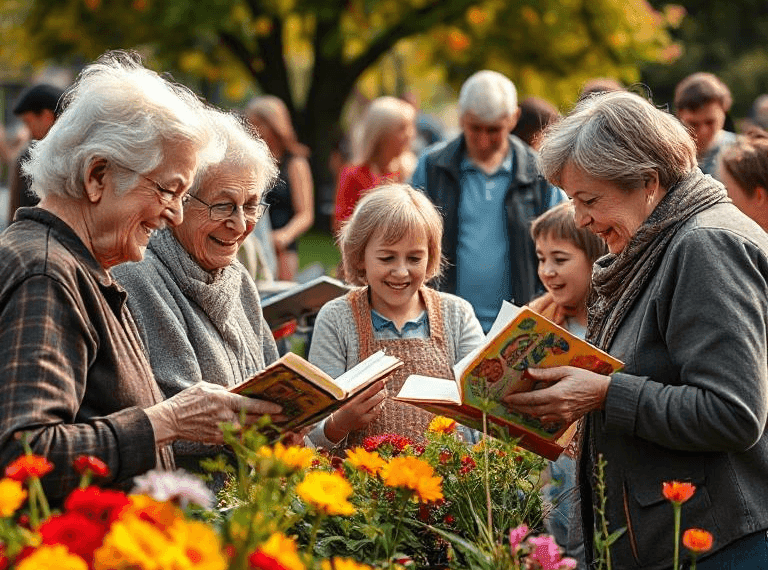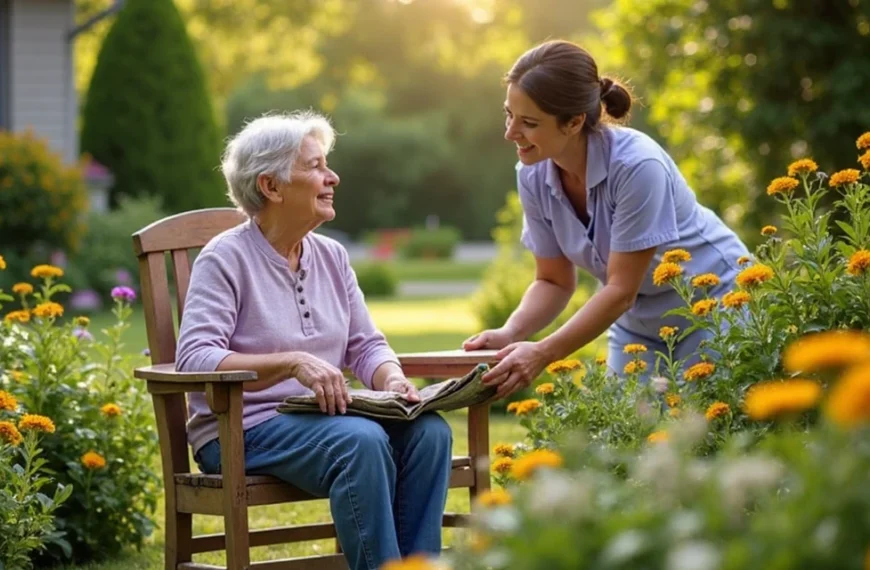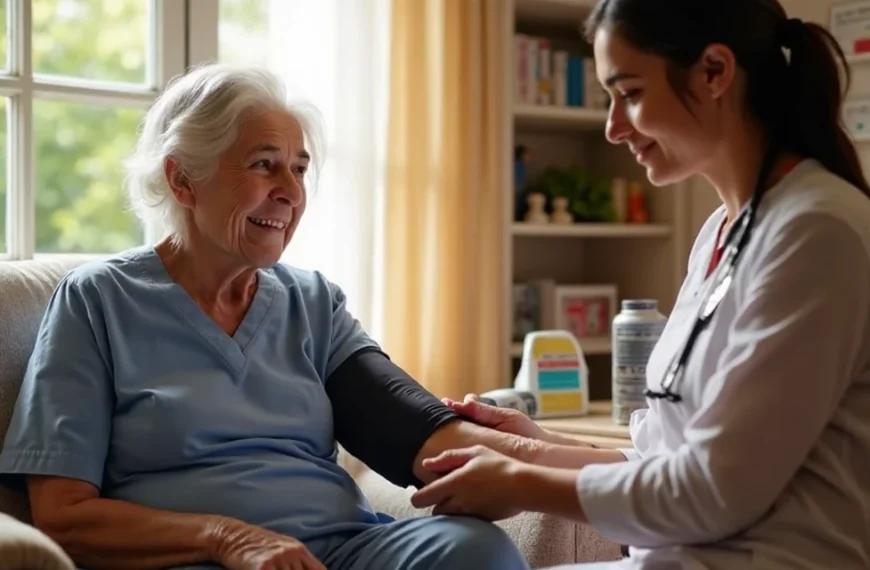Many of us wish to age gracefully. As we get older, live-in caregiver home senior elderly care becomes crucial. It’s important to get daily living assistance for elderly people to keep them well and happy. In Canada, senior care includes medical and non-medical help to let seniors live with dignity.
More than 20% of seniors over 85 need help with daily tasks. This shows how vital specialized care is. Tasks like bathing and dressing are key parts of care plans. Take Margaret, an 85-year-old in Ontario. She needs help with bathing, dressing, and cooking. Thanks to in-home daily living assistance services, Margaret gets the help she needs at home.
In-home care offers more than just basic help. It includes social work and advanced care like palliative support. The aim is to make sure seniors like Margaret can live well despite their health needs. Canadian families facing aging loved ones need to plan well. They should focus on both daily and instrumental activities of daily living. Knowing about these areas helps improve the quality of life for seniors. It ensures they get the respect and dignity they deserve.
Understanding Daily Living Assistance for Seniors
Many seniors want to stay in their homes as they age. This need has grown for senior care assistance at home. These services help seniors stay independent by supporting them with daily tasks.
Senior care assistance covers a wide range of services. In-home care for seniors includes personal care, companionship, and medical services. It also includes homemaking and home modifications for safety.
In-home care helps seniors stay independent and improves their quality of life. It lets them control their daily routines, which is important for those with dementia. Elderly caregiver services are tailored to each senior’s needs, from meals to medical care.
- Preserving independence through daily routines and home modifications
- Enhancing quality of life with personalized and compassionate care
- Fostering meaningful relationships between caregivers and seniors
Activities of Daily Living (ADLs)
Activities of Daily Living (ADLs) are key tasks for living independently and healthily. They were first defined in the 1950s by Sidney Katz. ADLs help decide the care level for seniors. Experts like geriatricians and social workers check these activities. They look for health issues. Let’s dive into some important ADLs.
Bathing and Showering
Bathing and showering keep us clean and healthy. Seniors might need help with these tasks, especially if they have mobility problems.
Feeding
Feeding is about being able to eat on your own. Some seniors need help, especially if they have arthritis or stroke. They might get special utensils or help from caregivers.
Dressing
Dressing means picking and putting on clothes. Seniors might struggle with this due to less dexterity or mobility. They might get easier clothes and help with fasteners.
Toileting
Using the toilet on your own is important for dignity and hygiene. Seniors with mobility or cognitive issues might need help. This support can be physical or through bathroom changes.
Continence
Continence means controlling bowel and bladder. Help with continence is crucial, including managing products and ensuring timely bathroom visits. It’s key for the dignity and health of seniors.
Mobility
Mobility means moving safely and efficiently. Mobility issues can affect independence. Assistance includes aids, walking help, and physical therapy for balance and strength.
Supporting ADLs can greatly improve seniors’ lives. It helps them stay independent and dignified. Detailed ADL assessments are key for the right support and care.
Instrumental Activities of Daily Living (IADLs)
As the number of seniors grows, with 20% of Canada. population expected to be over 65 by 2030, it’s key to understand how to keep them independent. Instrumental Activities of Daily Living (IADLs) are complex tasks that help seniors live on their own. Research shows that 62% of seniors face challenges with at least one IADL, making IADL support essential.
Housekeeping
Keeping a home clean and safe is crucial for health. Many seniors struggle with housekeeping tasks without IADL support. Getting help can prevent falls and improve their health.
Meal Preparation
Preparing healthy meals is important for seniors’ health. But, many older adults need help with this. Needing more help with meal prep often means they’re losing independence.
Shopping
Shopping for groceries and other essentials is vital. Trouble with these tasks can lead to poor nutrition. Getting help with shopping and transportation can help seniors stay independent.
Transportation
Being able to get around is a big part of staying independent. Trouble with driving or using public transport can limit seniors’ community activities. Reliable transport options are key to keeping them independent.
Assessing the Need for Daily Living Assistance
Checking if seniors need daily living help is the first step to keeping them happy and healthy. We use senior care evaluation methods and tools to figure out what they need. This helps us create a care plan that fits their life.
A 2011 survey in the U.S. found that many older adults need help with daily tasks. For example, 20.7% of those 85 and older needed help. This shows why regular checks are important. Research shows that losing the ability to do daily tasks can lead to serious health issues. It can cause seniors to go to the hospital or lose their mental sharpness. Healthcare experts use special tools to see how much help seniors need. The Katz Index and the Lawton IADL Scale are common tools. They help figure out how independent someone is.
Home support services are also crucial for seniors. They help with things like getting around, eating, and staying clean. To get home support, seniors need a health check and a look at their finances. This helps set the right rate for their care. Using the right tools and doing thorough checks helps us meet the needs of our aging community.
Live-in Caregiver Home Senior Elderly Care Comprehensive Daily Living Assistance
Families must choose between live-in care and long-term senior homes. Costs vary, but live-in care can be more affordable than nursing homes. Caregivers in live-in settings provide personal care, manage medications, and offer companionship. This support helps seniors stay independent and happy. Government programs also help with costs.
Live-in care is often cheaper than nursing homes. It saves on room and board costs but still offers quality care with variety personal options that families can make informed choices.
Personalized Senior Care
Personalized senior care is key to meeting each senior’s unique needs. Caregivers work closely with each senior., they make sure the care matches the senior’s specific needs and likes. They also offer special care for those with Alzheimer’s or dementia. This care helps manage behaviour and improves life quality.
Full-Time Caregiver for Seniors
For seniors needing a lot of help, a full-time caregiver is a big help. Carefect’s caregivers are there all the time. They help with complex medical needs, manage medicines, and act quickly in emergencies.
This kind of care is vital for seniors with ongoing health issues or those recovering from the hospital. It also helps prevent accidents caused by balance problems or weakness.
Full-time caregivers also provide emotional and social support. This is especially important for seniors dealing with depression, anxiety, or feeling lonely. By choosing caring and skilled caregivers, seniors can stay in their homes. They can enjoy the comfort and familiarity they love.
Benefits of In-Home Care for Seniors
Choosing in-home care for seniors is backed by both numbers and personal stories. Over 85% of older adults want to stay in their homes as long as they can. This shows the many benefits of in-home care, like keeping routines and enjoying familiar places while getting the help they need to live well on their own.
Comfort and Familiarity
In-home care lets seniors stay in their own homes, surrounded by what they love. This comfort boosts their mood, fights loneliness, and makes life better. It also makes them feel safe and less stressed, avoiding the worries of moving to new places.
Customized Care Plans
Every senior is different, needing unique care. In-home care lets caregivers create plans that fit each person’s health, diet, and personal needs. This means seniors get the right support to handle daily tasks easily and happily. For example, ComForCare offers flexible schedules and caregiver matches that meet each person’s specific needs, showing the value of tailored care.
One-on-One Attention
One-on-one care in homes means seniors get all the attention they need. Caregivers can watch health closely, stop problems early, and act fast in emergencies. They help with meals, rides, and personal care, keeping seniors independent and happy. This is key because older people often face mobility issues and feel lonely, but one-on-one care helps a lot.
Choosing the Right Elderly Home Caregiver
Choosing caregivers for our elderly loved ones is very important. It affects their quality of life and well-being. Home care services let seniors get care in their own homes, which is comforting.
Trustworthy home caregivers do more than just physical tasks. They also offer emotional support and fun activities. This helps seniors with Alzheimer’s or dementia feel safe and happy at home.
Choosing professional caregivers is crucial. They need to be kind, caring, and well-trained. This ensures seniors stay independent and families feel at ease. Checking references and reading reviews helps find reliable caregivers.
It’s important to think about what seniors need. This includes help with daily tasks, preventing falls, and getting to appointments. Understanding the costs of care is also key, whether it’s through agencies or private caregivers.
Getting everyone involved, like family members, is important. Talking openly with the senior being cared for is also crucial. By doing this, we make choices that really matter to our loved ones.
The Role of Family Caregivers
Family caregivers are key to keeping seniors happy and healthy. They do lots of things like cleaning, laundry, and helping with medicine. They also watch over their health and help them move around.
Most caregivers are in their 40s, working while caring for someone older. Adding home care assistance helps them a lot. It makes life better for seniors by keeping them active and connected.
More men are now caregivers, showing a big change. But, most seniors still have just one unpaid helper.
Being a caregiver is tough. Many spend over 40 hours a week caring for someone. They often do this for years, showing their dedication.
They do more than just help with daily tasks. They also keep seniors company and make them feel better. This helps seniors feel less lonely and happier.
But, caregiving can hurt the caregiver’s health. It’s especially hard for elderly spouses. So, giving them breaks is very important.
Home care agencies offer care that respects seniors’ wishes. They help keep seniors independent and proud. These caregivers are truly essential in caring for seniors.
Signs Your Loved One Needs Assistance with ADLs
It’s important to know when our elderly family members need help with daily tasks. There are clear signs that show when it’s time to get extra support. Here are some key signs that your loved one might need help with Activities of Daily Living (ADLs).
- Poor bathing habits like avoiding showers or baths for several days.
- Struggling with dressing, evidenced by wearing inappropriate clothing such as pajamas all day.
- Unkempt grooming habits, such as long, untrimmed nails.
- Difficulty managing toileting needs, which can lead to frequent accidents.
- Problems with eating, resulting in choking or significant weight loss.
Decline in Cognitive Abilities:
- Frequent forgetfulness, such as misplacing everyday items like keys.
- Confusion with familiar faces or places, leading to disorientation.
- Struggling with daily tasks such as cooking or handling finances.
- Significant memory loss that impacts daily living and life events.
- Difficulty with decision-making and problem-solving.
Poor Medication Management:
- Forgetting to take medications on time or taking incorrect dosages.
- Experiencing adverse effects due to medication errors.
- Feeling overwhelmed by managing multiple medications.
Decline in Physical Health:
- Unexplained weight loss signalling potential health issues.
- Limited mobility, necessitating assistance.
- Increased falls or accidents at home.
- Chronic pain that impacts the ability to perform daily activities.
- Neglecting personal hygiene due to mobility or cognitive challenges.
Social Isolation and Loneliness:
- Reduced social interactions leading to feelings of isolation.
- Withdrawal from activities that were previously enjoyable.
- Openly expressing or showing signs of loneliness.
Safety Concerns and Home Hazards:
- Presence of tripping hazards such as loose cords and clutter.
- Obstructed pathways that hinder safe movement.
- Loose rugs that pose a fall risk if not properly secured.
- Bruising from falls, indicating mobility challenges related to bathing.
By watching for these signs, caregivers can provide the right support. This helps keep their loved ones safe and independent, improving their quality of life.
Understanding the Katz Index of Independence in Activities of Daily Living
The Katz Index is a tool used in healthcare to check how well older adults can do daily tasks. It looks at six basic activities: bathing, dressing, toileting, transferring, continence, and feeding. Each task is scored as 1 for doing it alone or 0 for needing help.
A total score of 6 means someone is very independent. A score of 0 shows they need a lot of help.
Independence and Scoring
The ADL scoring system has been around for over thirty-five years. It has changed a bit over time. Doctors and nurses use it in hospitals, nursing homes, and home care to see how well patients can do things.
A score of 6 means a patient can do things on their own. A score of 0 means they need a lot of help. Scores between 4 and 0 show they need some help with daily tasks.
Using the Katz Index to Monitor Elderly Independence
The Katz Index helps track how independent older adults are over time. It’s good at spotting when someone can’t do daily tasks as well as before. This helps caregivers plan better care.
Even though it mainly looks at basic tasks, other tests might be needed to see more detailed changes. Despite some drawbacks, the Katz Index is still useful for planning care and helping with discharge.
Importance of Regular Senior Care Assessments
Regular care assessments are key to keeping our senior loved ones healthy and happy. These checks happen often and are crucial for watching over their health. They help spot any changes in their physical or mental state that might need changes in their care.
By planning care that changes with our elders’ needs, we make sure they get the best care. We work with doctors, families, and seniors to get all the important details. This way, we make sure the care plans are always up-to-date and meet each senior’s unique needs.
93% of older adults prefer to receive care services in their own homes. This shows how important it is to keep them safe and comfortable at home. Regular checks also help prevent problems like depression and improve their quality of life.
Our method for regular care assessments is detailed:
- First, we talk with seniors, their families, and doctors.
- Then, we create care plans that fit their needs.
- Finally, we keep checking and updating the plans as needed.
This careful approach makes sure we’re always ahead of any health issues. Regular checks help us act fast, improving seniors’ health and happiness. Plus, it helps them stay in their homes, aging with dignity and comfort.
The Functional Independence Measure (FIM)
The Functional Independence Measure (FIM) is key in elder care. It shows how well a senior can do daily tasks. The FIM score is important for measuring senior independence. It looks at physical and mental skills, giving a full picture of a person’s abilities.
Higher scores mean a senior can do more on their own. This helps doctors decide the right care level.
Physical and Mental Capacity
The FIM tool checks many things. It looks at how well a senior moves, takes care of themselves, talks, and thinks. This detailed check helps caregivers make care plans that fit each person’s needs.
Assessment and Scoring
The FIM goes beyond simple daily tasks. It also looks at social and thinking skills. This gives a complete view of a senior’s abilities.
Studies show that seniors with higher FIM scores do better. They are more likely to go home after rehab, not to long-term care.
Caregiver Support and Training
It’s vital to support caregivers with good training and education. In Canada, many resources help with this. They improve caregivers’ skills and the seniors’ well-being.
Importance of Educated Caregivers
Educated caregivers are key in healthcare. They greatly improve seniors’ lives. Island Health’s Caregiver Support Program offers counseling, classes, and support groups.
These help caregivers handle their duties well.
Resources for Caregiver Training
Good resources are key for caregiver training. Family Caregivers of BC has a toll-free line for support. Island Health uses phones and computers for support too.
Respite care and Adult Day Services on Vancouver Island give caregivers a break. They ensure seniors get quality care.
Supporting caregivers and their education is crucial. It helps keep the elderly’s dignity and independence. Community and home services provide vital help.
Differences Between Basic and Instrumental ADLs
It’s important to know the difference between basic and instrumental ADLs for senior care. Basic ADLs include dressing, eating, and bathing. These are basic needs for daily life. On the other hand, instrumental ADLs, or IADLs, are more complex. They include managing money, cooking, and taking medication. These tasks need better thinking and planning skills.
At Encompass Health, patients learn both ADLs and IADLs in a home-like setting. They work with therapists to reach their goals. This practice helps them get ready to go home and live independently again.
Checking on ADLs and IADLs helps figure out what care a senior needs. Trouble with basic ADLs means they might need help or supervision. But, problems with IADLs could mean early signs of dementia. This calls for early action to keep them safe.
Understanding the difference between basic and instrumental ADLs helps create better care plans. Keeping seniors independent in these areas improves their quality of life. So, it’s key to assess and support both types of ADLs to meet each senior’s unique needs.
Customized Senior Care Plans Based on ADL Needs
Creating a care plan for the elderly means focusing on their unique needs. This approach ensures seniors get support that fits their lifestyle. It helps them stay independent and live better lives.
Every elderly care plan is made just for that person. It covers everything from daily tasks to managing medicine and staying connected. This way, we can spot health issues early and manage them better.
These plans involve many healthcare experts. Doctors, nurses, and social workers all play a part. They make sure care is all-encompassing and meets the senior’s wishes. This includes talking to families to understand what’s important to the senior.
These care plans are always being updated. They might include:
- Help with daily tasks
- Physical therapy and managing medicine
- Fun activities and getting around
- Medical care and keeping the home safe
By focusing on ADLs, we offer support that’s truly personal. This way, seniors can live with dignity and freedom. It’s important to keep talking with the care team to adjust to any changes.
In the end, care plans based on ADLs offer a flexible yet structured way to care for the elderly. It ensures each person gets the best life possible.
Working with Senior Care Providers in Canada
Working with senior care providers in Canada means knowing the many resources and services available. This ensures our elderly loved ones get the support they need. In Canada, there are many ways to get care, like in-home care, retirement homes, and long-term care facilities. Each option has its own costs, including private insurance, government help, and community support.
In-home care is often paid for by pensions or other money seniors have. Insurance might help cover some of the costs. In places like British Columbia, community health workers are key in helping seniors. They help with daily tasks like bathing and taking medicine. Working with these caregivers means care is tailored to each person’s needs.
Retirement homes and long-term care facilities in Canada get funding from different places. The OAS and CPP pension funds help pay for it. There’s also government help that can be up to $1,891 a month. Caregivers might also get tax credits, which can help with costs. Knowing about these financial aids and working well with care providers makes sure seniors get the best care possible.





